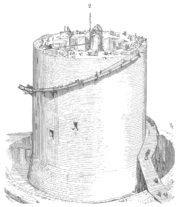
Putlog holes
Encyclopedia
Putlog holes, as the name implies, are small holes that were intended to receive the ends of logs or squared wooden beams in the walls of buildings, especially in the Middle Ages
.
Sometimes these logs were used for temporary scaffolding
in construction, and sometimes they seem to have been used to ease the construction of hoardings
. Evidence for the former can sometimes be seen from the spiral pattern they have left on the surface of round towers.
The inconsequential size and the spacing of the holes meant that they did not affect the solidity of the walls.
Hoardings were useful, as they gave archers greater mobility and a wider field of fire in times of siege; they also (through holes in the floor) facilitated dropping boulders (etc) directly onto the enemy's heads, without the need to expose oneself to danger.
In well-preserved castles, like Beaumaris
, the putlog holes can be seen to this day.
Putlog holes are still used in modern scaffolding.


Middle Ages
The Middle Ages is a periodization of European history from the 5th century to the 15th century. The Middle Ages follows the fall of the Western Roman Empire in 476 and precedes the Early Modern Era. It is the middle period of a three-period division of Western history: Classic, Medieval and Modern...
.
Sometimes these logs were used for temporary scaffolding
Scaffolding
Scaffolding is a temporary structure used to support people and material in the construction or repair of buildings and other large structures. It is usually a modular system of metal pipes or tubes, although it can be from other materials...
in construction, and sometimes they seem to have been used to ease the construction of hoardings
Hoarding (castles)
A hoarding was a temporary wooden construction that was placed on the exterior of the ramparts of a castle during a siege.The purpose of a hoarding was to allow the defenders to improve their field of fire along the length of a wall and, most particularly, directly downwards to the wall base.The...
. Evidence for the former can sometimes be seen from the spiral pattern they have left on the surface of round towers.
The inconsequential size and the spacing of the holes meant that they did not affect the solidity of the walls.
Hoardings were useful, as they gave archers greater mobility and a wider field of fire in times of siege; they also (through holes in the floor) facilitated dropping boulders (etc) directly onto the enemy's heads, without the need to expose oneself to danger.
In well-preserved castles, like Beaumaris
Beaumaris Castle
Beaumaris Castle, located in the town of the same name on the Isle of Anglesey in Wales, was built as part of King Edward I's campaign to conquer the north of Wales. It was designed by James of St. George and was begun in 1295, but never completed...
, the putlog holes can be seen to this day.
Putlog holes are still used in modern scaffolding.
Gallery



